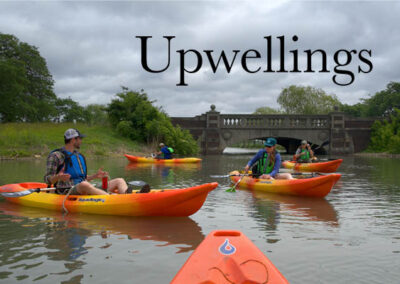Michigan Sea Grant staff launched monitoring projects and coordinated public outreach to help Ottawa County Parks and Recreation better understand pre-restoration fish populations at a popular West Michigan park.
Ottawa County is a beloved recreation hub along Lake Michigan. In recent years, a 345-acre former sand mine was converted into Ottawa Sands County Park. The park includes forested dunes, an 80-acre inland lake, and riverfront wetlands. Already well-used by the community, the park was selected for further development and habitat restoration to become a regional tourism highlight.
Seeing major construction and ecological restoration projects on the horizon, Ottawa County Parks and Recreation (OCPR) staff partnered with local natural resources experts to help paint a picture of the park’s existing habitats and lay the groundwork for future monitoring.
In 2018, OCPR turned to Dan O’Keefe, Michigan Sea Grant (MISG) Extension educator for West Michigan, for help with public outreach and assessments of fish populations in Ottawa Sands’ inland lake.

Dan runs outdoor youth engagement programs that teach kids to fish. In early 2023, he worked with high school students from CA Frost Science Academy in Grand Rapids and middle schoolers from Walden Green Montessori. Photo: Katelyn Brolick, MISG.
The park has now become an annual fixture in Dan’s summer work. In 2022, he and other MISG staff partnered with the Michigan Department of Natural Resources and Ottawa County to run a one-day fish sampling blitz at the park to engage students in measuring and identifying fish. Later, he leveraged angler data and a community fishing event to develop an improved assessment of the park’s bass population. He also turned the bass data into lesson plans for future field trips and laboratory exercises.
These efforts led to hands-on engagement opportunities for students and community members, some of whom caught the first or biggest fish of their lives. OCPR expressed strong interest in the data and MISG’s input as they moved forward with habitat restoration, development, and possible changes to fishing regulations for the park.
Dan’s work showed that largemouth bass and bluegill are the most common species in the Ottawa Sands lake. Smallmouth bass and yellow perch are also present, along with sand shiners, bluntnose minnows, and banded killifish.
“Our pre-restoration monitoring suggested that the ratio of bluegill to bass is too low,” said Dan. “As a result, large bass have trouble finding enough food, which is clear from their poor body condition.”

Large bass have trouble finding enough food at Ottawa Sands, often weighing 20-40% less than what they should weigh based on length.
Adding woody habitat in shallow areas of the lake would give small bluegill a place to hide from predators. The bluegill could also eat invertebrates that thrive off the addition of wood.
“We hope the wood will allow more young bluegill to grow to a size where they can provide a decent meal for larger bass,” Dan said.

Root wads and trees with numerous small branches provide the best cover for small bluegill and bass.
As MISG’s biodiversity assessments were underway, researchers from the Annis Water Resources Institute at Grand Valley State University were also testing water quality and inventorying macroinvertebrates, the tiny creatures living in sediments at the bottom of the lake. See their 2024 paper from the journal Inland Waters for a deeper dive into their findings.
2023 marked Dan’s sixth year of assisting OCPR with pre-restoration fish monitoring. He devised a monitoring plan for assessing bluegill populations and helped county staff deploy fyke nets to catch bluegill for a pre-impact study. Approximately 110 students from two schools joined MISG-led participatory science field trips to sample the lake’s largemouth bass. MISG also purchased supplies, including underwater cameras and experimental nets, for future monitoring.
In 2023, Ottawa County received a $142,800 grant from the Michigan DNR Fisheries Habitat Grant Program. This funding and additional support from public and private sources enabled OCPR to begin the Ottawa Sands restoration work in 2024.
The park remained closed through much of 2024 while extensive construction projects expanded and improved parking, restroom, and camping facilities at the site. Ecological restoration projects also created and improved habitats on land and in the water.
As OCPR announced in a March 2024 press release, “The project will help to conserve, improve, and create habitat for animals that utilize wetland communities, especially secretive marsh birds, other migratory birds, herpetofauna, and various fish species.”
Overall, the active ecological restoration is intended to cover at least 26 acres of the site. The habitat restoration work includes:
- Softening 3,300 feet of shoreline around the lake.
- Adding woody debris along the shoreline and within the lake to create habitat.
- Converting six acres of filled-in mining lagoon to interdunal wetland as habitat for birds and amphibians, and as green infrastructure to slow and absorb rain and snowmelt.
- Constructing a 2-acre wetland connected to the inland lake as additional habitat for small fish and other wildlife.
Dan visited the site in September 2024, before the park reopened to the public, and already reported evidence of fish using the new underwater habitats.
The park’s grand reopening celebration is scheduled for October 17, 2024, at 4-6:30pm and will be free and open to the public.


